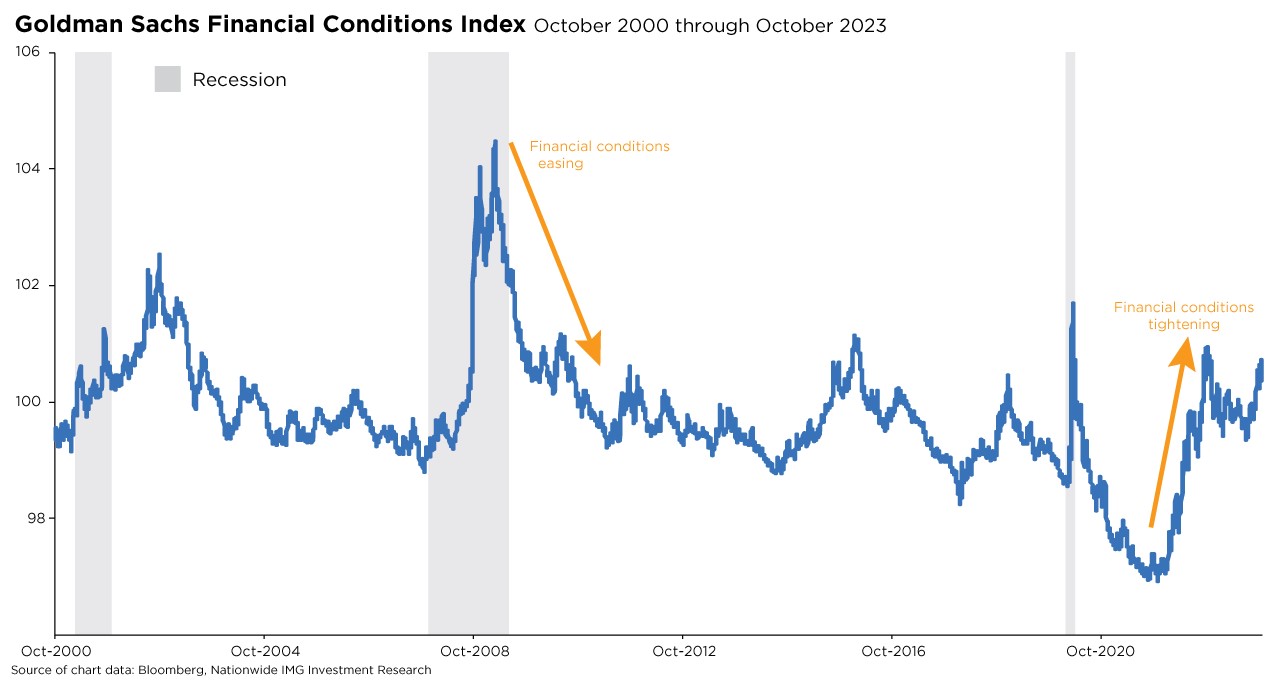Shifts in stock market leadership can be extreme
Small caps have led the market recently, taking over from large caps. What will it take for the rally to continue?

As the third quarter earnings season winds down, investors are deciphering a cautionary narrative told through the latest round of earnings reports. Corporations are offering subdued guidance despite better-than-expected earnings and the deterioration in sales guidance, which suggests many firms are telegraphing a somewhat conservative outlook for the economy.
This may be an indirect way of saying that tighter financial conditions due to higher interest rates and unease about the lagging effects of the Federal Reserve’s rate hikes have the potential to slow economic growth. Understanding the meaning of “financial conditions” can be valuable for investors because changes in monetary policy essentially impact financial conditions.

While “financial conditions” can be measured in various ways, four components might help investors consider the term’s meaning. These components generally include the U.S. dollar, corporate bond spreads, equity market levels, and interest rate levels. Each component can influence the economy differently; for example, recent strength in the U.S. dollar generally lowered Q3 earnings and revenues for the S&P 500® Index firms with more international exposure compared to those companies with greater domestic exposure. Likewise, the rise in the 10-year U.S. Treasury yield to nearly 5% (the highest level since 2007) illustrates how the cost of capital for corporations and consumers has become increasingly prohibitive. Broadly speaking, an increase in the U.S. dollar blunts growth, wider corporate spreads decrease investment, lower equity prices quell the wealth effect of consumers, and higher rates increase the cost of capital for consumers and corporations—all of which weigh on economic activity.
There are a few barometers of financial conditions, such as the Goldman Sachs’ Financial Conditions Index, that attempt to capture numerous financial and economic variables to reflect tight or loose financial conditions. Investors can view these indexes as scorecards that measure the impacts of different factors on the economy, businesses, and consumers. For example, the accompanying chart shows an upward tick in the index in the last several months, indicating that financial conditions have become tighter. According to some analysts, the recent tightening is the equivalent of approximately 100 basis points of Fed rate hikes.
Most financial condition indexes should be viewed as a gauge of what’s currently happening in the economy rather than a tool to predict future growth or portfolio performance. To illustrate, financial conditions were very tight during the bear market low in 2022, yet stocks have rallied since then, and GDP proved more resilient than tighter financial conditions would imply.
This material is not a recommendation to buy or sell a financial product or to adopt an investment strategy. Investors should work with their financial professional to discuss their specific situation.
Except where otherwise indicated, the views and opinions expressed are those of Nationwide as of the date noted, are subject to change at any time and may not come to pass.
S&P 500® Index: An unmanaged, market capitalization-weighted index of 500 stocks of leading large-cap U.S. companies in leading industries; it gives a broad look at the U.S. equities market and those companies’ stock price performance.
S&P Indexes are trademarks of Standard & Poor’s and have been licensed for use by Nationwide Fund Advisors. The Products are not sponsored, endorsed, sold or promoted by Standard & Poor’s and Standard & Poor’s does not make any representation regarding the advisability of investing in the Product.
Nationwide Funds are distributed by Nationwide Fund Distributors LLC, member FINRA, Columbus, Ohio. Nationwide Investment Services Corporation, member FINRA, Columbus, Ohio.
Nationwide, the Nationwide N and Eagle and Nationwide is on your side are service marks of Nationwide Mutual Insurance Company. © 2023 Nationwide
NFN-1544AO